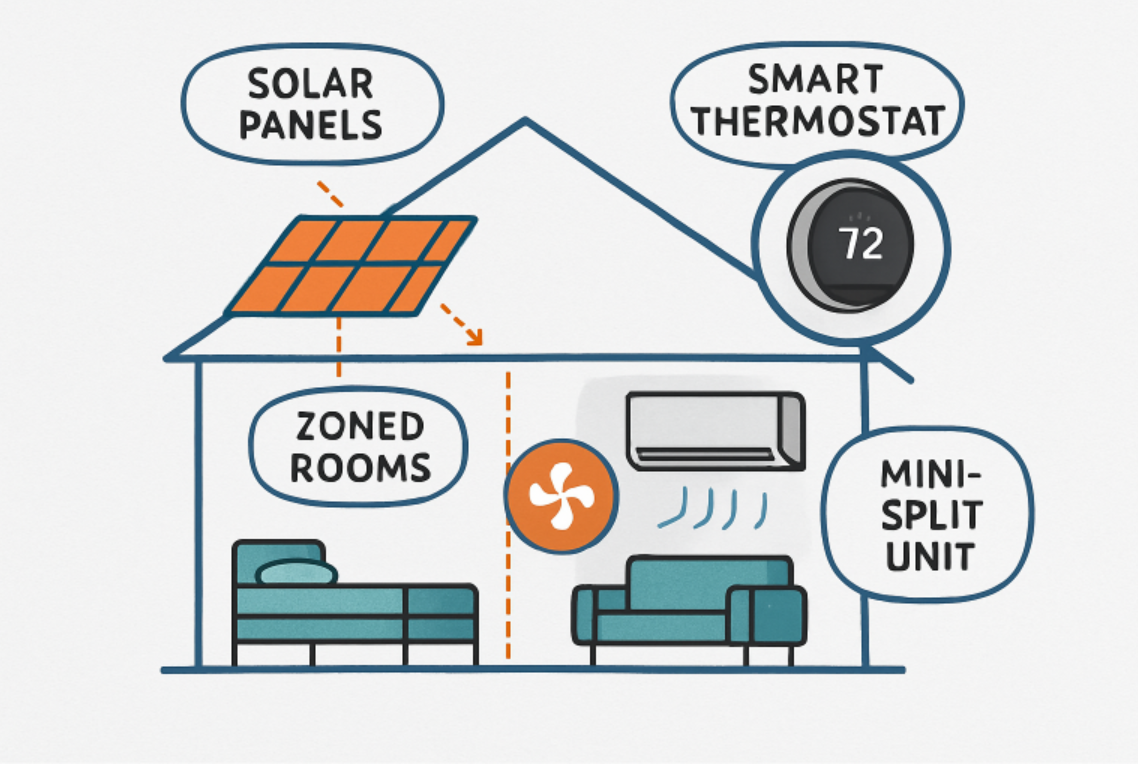Modern homeowners are seeking more innovative, simpler ways to manage indoor comfort throughout the year. Whether keeping cool in blazing summer heat or cozy throughout winter’s chill, today’s technological advancements set new standards for living well indoors. With solutions ranging from intuitive smart controls to sustainable design practices, effortless comfort is increasingly within reach. Homeowners can also explore practical options, such as mini split heating and cooling, to further streamline climate management with high efficiency.
Intelligent climate control goes beyond adjusting the thermostat—it leverages automation, learning algorithms, and even the sun’s energy to strike a balance between comfort and sustainability. These innovations not only enhance daily life but can also cut energy use and lower utility bills. As home environments become more connected and adaptive, maximizing comfort no longer means sacrificing convenience or environmental responsibility.
Smart Thermostats: The Brain of Home Climate Control
Gone are the days of manually adjusting the heat or air conditioning several times a day. Smart thermostats combine user-friendly tech with learning capabilities, adapting to busy schedules and personal preferences over time. For instance, the latest models not only streamline local temperature control but also integrate with digital assistants and remote sensors. This means heating and cooling only where and when needed, maximizing comfort while minimizing wasted energy. According to ENERGY STAR, smart thermostats can help users save approximately $100 annually on heating and cooling bills.
Zoning Systems: Personalized Comfort in Every Room
Many traditional homes rely on a single thermostat, making it difficult to cater to individual comfort needs in different rooms. Zoning systems empower homeowners to control the temperature in distinct areas independently—think keeping nurseries warm while bedrooms stay cool. This precision not only reduces arguments over thermostat settings but also prevents energy waste in unused spaces. As highlighted by the U.S. Department of Energy, zoning can boost household energy savings by up to 25%, making it an integral improvement for modern residences.
Passive Solar Design: Harnessing Nature’s Energy
Passive solar design is an innovative architectural strategy that leverages natural elements to enhance energy efficiency. By carefully orienting buildings to capture the sun’s rays during colder months while minimizing heat gain in warmer periods, this approach optimizes indoor comfort throughout the year. Strategic window placement allows sunlight to penetrate living spaces, while thermal mass materials—such as concrete, brick, or stone—absorb, store, and gradually release heat, reducing the need for mechanical systems. Additionally, features like overhangs, shading devices, and natural ventilation help maintain a balanced indoor climate. According to Architectural Digest, these techniques are increasingly being adopted by homeowners seeking to lower their energy bills, minimize environmental impact, and create sustainable, comfortable living spaces that seamlessly integrate with nature. Passive solar design offers both economic and ecological benefits.
AI Integration: Learning Your Preferences
Artificial intelligence is redefining climate control with systems that constantly learn from your habits and environmental conditions. These AI-powered platforms assess occupancy, outdoor weather forecasts, and air quality, making micro-adjustments in real-time. Many can predict equipment maintenance needs, sending alerts before minor inefficiencies become costly repairs. As reported in industry news, this proactive approach helps households stay comfortable and avoid surprising energy spikes or unexpected HVAC malfunctions.
Voice-Activated Controls: Hands-Free Convenience
The rise of voice assistants has fundamentally changed how we interact with our homes. With simple commands, homeowners can adjust temperatures, change climate modes, or activate scheduled routines—all without lifting a finger. This seamless experience is ideal both for households with accessibility needs and for anyone who values multitasking. Integration with platforms such as Amazon Alexa or Google Assistant ensures compatibility with numerous home automation systems for a unified smart home experience.
Energy-Efficient HVAC Systems: Sustainable Comfort
Today’s HVAC systems are equipped with technologies designed to minimize environmental impact while maximizing comfort. Variable-speed compressors, advanced air filtration, and precise controls all contribute to a smaller carbon footprint. While the initial investment is often higher, homeowners regularly recoup costs through ongoing utility savings. According to the U.S. Environmental Protection Agency’s ENERGY STAR program, upgrading to energy-efficient HVAC equipment is one of the most cost-effective steps to reduce household energy use and environmental impact.
Natural Ventilation: Time-Tested Cooling Methods
Leveraging architectural strategies for natural ventilation provides an inexpensive and environmentally friendly supplement to mechanical climate control. This traditional approach involves cross-breeze designs, operable skylights, and strategic vent placement that invite fresh air to flow naturally through living spaces. Particularly for homes with heritage value or energy-conscious renovators, these solutions deliver cooler interiors and improved air quality with minimal resource use. Research published in Scientific American demonstrates that even minor improvements to ventilation and shade can make significant differences in cooling performance.
Conclusion
Modern climate control strategies seamlessly integrate advanced technology, innovative design, and a strong focus on sustainability to redefine how we experience comfort at home. By adopting cutting-edge solutions—ranging from smart thermostats that learn user habits to passive solar design that naturally regulates temperature—households can significantly reduce energy consumption while lowering utility bills. Options such as mini-split systems provide efficient heating and cooling without extensive renovations, while AI-driven automation ensures optimal energy use with minimal effort. Incorporating natural ventilation and strategically placed shading further enhances comfort while supporting eco-friendly practices. These approaches allow homeowners to craft a personalized climate solution that reflects both their lifestyle preferences and environmental values. Ultimately, modern strategies demonstrate that achieving a comfortable living environment and promoting sustainability are not mutually exclusive but complementary goals for the contemporary household.

